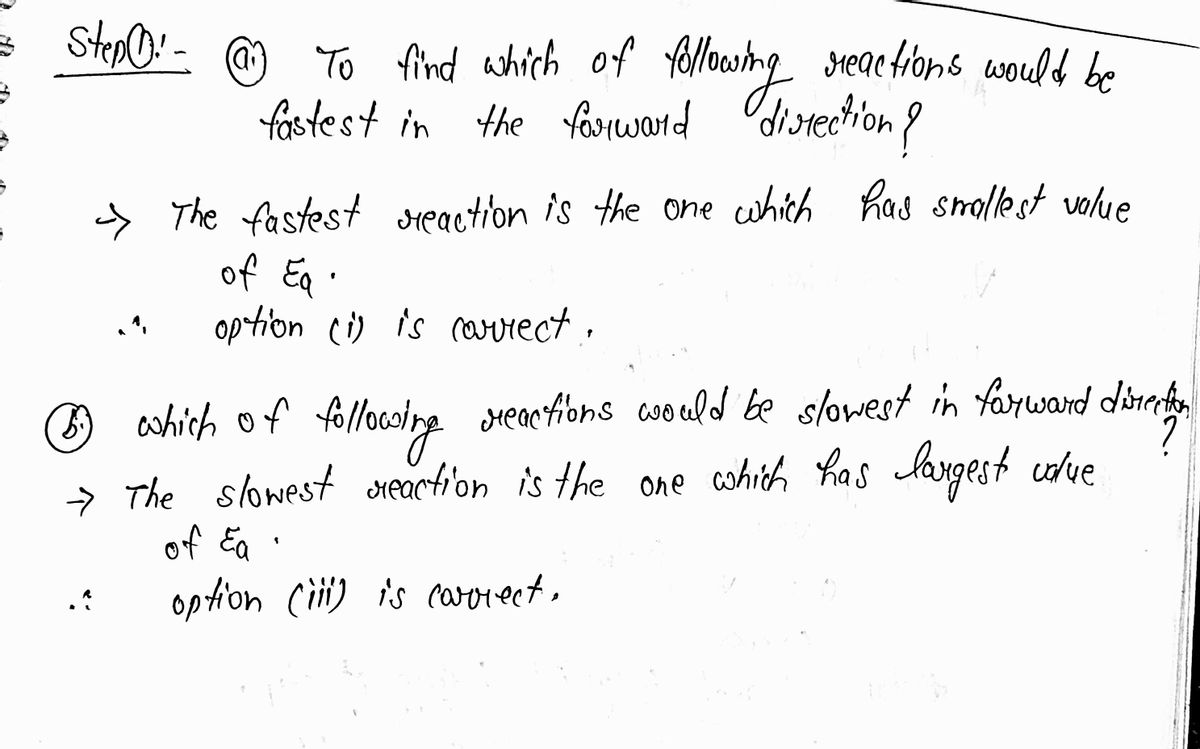Based on activation energies and energy changes and assuming that all collision factors are the same, answer the following questions: (a) Which of the following reactions would be fastest in the forward direction? Ea = 30 kJ/mol;E = -10 kJ/mol Ea = 40 kJ/mol;E = -20 kJ/mol Ea = 80 kJ/mol;E = 60 kJ/mol Ea = 60 kJ/mol;E = -40 kJ/mol (b) Which of the following reactions would be slowest in the forward direction? Ea = 30 kJ/mol; E = -10 kJ/mol Ea = 40 kJ/mol; E = -20 kJ/mol Ea = 80 kJ/mol; E = 60 kJ/mol Ea = 60 kJ/mol; E = -40 kJ/mol (c) Which of the following reactions would be fastest in the reverse direction? Ea = 30 kJ/mol; E = -10 kJ/mol Ea = 40 kJ/mol; E = -20 kJ/mol Ea = 80 kJ/mol; E = 60 kJ/mol Ea = 60 kJ/mol; E = -40 kJ/mol (d) Which of the following reactions would be slowest in the reverse direction? Ea = 30 kJ/mol; E = -10 kJ/mol Ea = 40 kJ/mol; E = -20 kJ/mol Ea = 80 kJ/mol; E = 60 kJ/molEa = 60 kJ/mol; E = -40 kJ/mol
Based on activation energies and energy changes and assuming that all collision factors are the same, answer the following questions: (a) Which of the following reactions would be fastest in the forward direction? Ea = 30 kJ/mol;E = -10 kJ/mol Ea = 40 kJ/mol;E = -20 kJ/mol Ea = 80 kJ/mol;E = 60 kJ/mol Ea = 60 kJ/mol;E = -40 kJ/mol (b) Which of the following reactions would be slowest in the forward direction? Ea = 30 kJ/mol; E = -10 kJ/mol Ea = 40 kJ/mol; E = -20 kJ/mol Ea = 80 kJ/mol; E = 60 kJ/mol Ea = 60 kJ/mol; E = -40 kJ/mol (c) Which of the following reactions would be fastest in the reverse direction? Ea = 30 kJ/mol; E = -10 kJ/mol Ea = 40 kJ/mol; E = -20 kJ/mol Ea = 80 kJ/mol; E = 60 kJ/mol Ea = 60 kJ/mol; E = -40 kJ/mol (d) Which of the following reactions would be slowest in the reverse direction? Ea = 30 kJ/mol; E = -10 kJ/mol Ea = 40 kJ/mol; E = -20 kJ/mol Ea = 80 kJ/mol; E = 60 kJ/molEa = 60 kJ/mol; E = -40 kJ/mol
Chemistry
10th Edition
ISBN:9781305957404
Author:Steven S. Zumdahl, Susan A. Zumdahl, Donald J. DeCoste
Publisher:Steven S. Zumdahl, Susan A. Zumdahl, Donald J. DeCoste
Chapter1: Chemical Foundations
Section: Chapter Questions
Problem 1RQ: Define and explain the differences between the following terms. a. law and theory b. theory and...
Related questions
Question
Based on activation energies and energy changes and assuming that all collision factors are the same, answer the following questions:
(a) Which of the following reactions would be fastest in the forward direction?
Ea = 30 kJ/mol;E = -10 kJ/mol
Ea = 40 kJ/mol;E = -20 kJ/mol
Ea = 80 kJ/mol;E = 60 kJ/mol
Ea = 60 kJ/mol;E = -40 kJ/mol
(b) Which of the following reactions would be slowest in the forward direction?
Ea = 30 kJ/mol; E = -10 kJ/mol
Ea = 40 kJ/mol; E = -20 kJ/mol
Ea = 80 kJ/mol; E = 60 kJ/mol
Ea = 60 kJ/mol; E = -40 kJ/mol
(c) Which of the following reactions would be fastest in the reverse direction?
Ea = 30 kJ/mol; E = -10 kJ/mol
Ea = 40 kJ/mol; E = -20 kJ/mol
Ea = 80 kJ/mol; E = 60 kJ/mol
Ea = 60 kJ/mol; E = -40 kJ/mol
(d) Which of the following reactions would be slowest in the reverse direction?
Ea = 30 kJ/mol; E = -10 kJ/mol
Ea = 40 kJ/mol; E = -20 kJ/mol
Ea = 80 kJ/mol; E = 60 kJ/molEa = 60 kJ/mol; E = -40 kJ/mol
Expert Solution
Step 1

Step by step
Solved in 2 steps with 2 images

Knowledge Booster
Learn more about
Need a deep-dive on the concept behind this application? Look no further. Learn more about this topic, chemistry and related others by exploring similar questions and additional content below.Recommended textbooks for you

Chemistry
Chemistry
ISBN:
9781305957404
Author:
Steven S. Zumdahl, Susan A. Zumdahl, Donald J. DeCoste
Publisher:
Cengage Learning

Chemistry
Chemistry
ISBN:
9781259911156
Author:
Raymond Chang Dr., Jason Overby Professor
Publisher:
McGraw-Hill Education

Principles of Instrumental Analysis
Chemistry
ISBN:
9781305577213
Author:
Douglas A. Skoog, F. James Holler, Stanley R. Crouch
Publisher:
Cengage Learning

Chemistry
Chemistry
ISBN:
9781305957404
Author:
Steven S. Zumdahl, Susan A. Zumdahl, Donald J. DeCoste
Publisher:
Cengage Learning

Chemistry
Chemistry
ISBN:
9781259911156
Author:
Raymond Chang Dr., Jason Overby Professor
Publisher:
McGraw-Hill Education

Principles of Instrumental Analysis
Chemistry
ISBN:
9781305577213
Author:
Douglas A. Skoog, F. James Holler, Stanley R. Crouch
Publisher:
Cengage Learning

Organic Chemistry
Chemistry
ISBN:
9780078021558
Author:
Janice Gorzynski Smith Dr.
Publisher:
McGraw-Hill Education

Chemistry: Principles and Reactions
Chemistry
ISBN:
9781305079373
Author:
William L. Masterton, Cecile N. Hurley
Publisher:
Cengage Learning

Elementary Principles of Chemical Processes, Bind…
Chemistry
ISBN:
9781118431221
Author:
Richard M. Felder, Ronald W. Rousseau, Lisa G. Bullard
Publisher:
WILEY